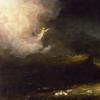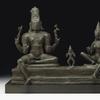Traditional Chinese Arts Highlight Gianguan Auctions' December 12 Sale
- NEW YORK , New York
- /
- November 24, 2018
The value of the offerings in Gianguan Auctions December 12 sale rest not only on the standards of rarity, design and craftsmanship but also on the symbolism projected. While Western collectors may overlook deeper meanings of the subject matter in paintings, on ceramics and carved into jade, Chinese collectors will take into account the messages of longevity, harmony, prosperity and happiness.
A highlight of this approach is “Snow Mountain,” an 11th century hanging scroll featured on the catalog cover. Created by court painter Guo Xi (1023-1085), who utilized idiomatic brushstrokes, the work is a rare example of the perspective known as “the angle of totality.” In this work, the artist renders a view of a distant mountain that ascends from a stream through the scree of falling rock to treeless terrain and culminates in roiling clouds, reflecting the aspirations of humans to attain a higher state of being. Signed Guo Xi, the work has eight Emperors’ seals and seventeen collectors’ seals. Lot 99, it is valued at $1.2 million or higher.
The sheer beauty of “Autumn Bouquet” by Jiang Tingxi (1669-1732) must be mentioned. Delicate shades of jade green and celadon are used in the vase and leaves while the addition of pale pink blossoms creates harmony. Signed Jiang Tingxi, with seven collectors’ seals and five colophons, Lot 202 is a good value at upwards of $15,000.
The tradition of seeking artistic truth through symbols has been carried through to the 20th century works of Xu Beihong (1895-1953) whose horses came to signify the indomitable spirit of the Chinese against invasions of the 1930s and 1940. In “Standing Tall” a regal horse presents a three-quarter profile. Steady but alert, its mane aflutter and tail poised in excitement, the animal is charged to release its power if challenged. Dated 1942, the ink-and-color on paper scroll is inscribed and signed Beihong and has one artist seal. It is Lot 135, valued at upwards of $20,000
Fu Baoshi (1904-1965), who brought Japanese techniques to Chinese ink painting and is generally recognized as the Father of the New Chinese Art Movement, is represented by a 1945 ink washed work entitled “Hither My Companions.” Monochromatic with pale pink and flesh tones, it interprets a day in the country that transcends the political exposition usually practiced by mid-century Chinese artists. The scroll is inscribed and signed Fu Baoshi, and bears three artist seals. Lot 151 is estimated to go off at more than $40,000.
Wu Qingxia (1910-2008), a female modernist, often used symbolism to express longing. “Geese,” 1979, sets within a pond two that gaze upwards at birds in flight while other pond birds dive and divert. The composition puts arcing boughs above the water fowl and the taunting birds at its pinnacle. Punctuating the chiaroscuro, blossoms pop in shades of gold and blue. Lot 37, (137 X 67.5 cm) will draw as much as $15,000.
Offsetting these traditional works is a collection of contemporary art that includes Hsia Yan’s (b. 1932) masterpiece “After George Seurat’s Sunday Afternoon.” The 1999 work sets the famous work within the framework of Fuzzy Line style, creating a visual restlessness. Lot 204, (94 X 128.3 cm), it is signed in Pinyin, dated and framed. The starting bid is $30,000.
Walasse Ting (1929-2010) is represented with a portfolio of poems on retouched lithos from “All In My Head.” Housed in a plexiglass box, Lot 240 will go for upwards of $7,000. Several works from his 1971 “Green Banana “series are listed in the non-reserved portion of the sale, Lots 245-248. “Taihang Mountain Home” by Ma Le (Ma Jianguo) b. 1963 is a masterwork of black striations that evoke ruggedness. Lot 95, it is about $5,000.
The paintings collection is peppered with entry level works ranging from $1,000 on up.
Meanwhile, the catalog cover Guanyin, crafted by celebrated 17th C potter He Chaozong embodies the master’s attributes: a sensitive face modeled with downcast eyes and a benevolent smile; graceful fingers and toes; a waist-knotted robe with detailed folds that indicate weight and a hem that billows behind. The signature glaze is thick, ivory. A He Chaozong seal mark is visible on the back along with a double gourd outline. A similar example resides in the Palace Museum. Lot 120 is 10 3/4” (26.8 cm) high, valued at upwards of $20,000.
A grouping of several lots offer buyers a selection of religious figures of various media. Lot 116 is a carved Northern Qi Dynasty Buddhist Stele of a seated Guanyin, with a starting bid of $5,000. Lot 117 is an impressive Northern Wei carved jade of a standing Sakyamuni Maitreya. At nearly 20” (48 cm) tall, it is well positioned to go off at $8,000 or more. Lot 118 is Song Dynasty stucco fresco of the god of Longevity offering a peach. Framed, the property is 50” (128 cm) X 37” (92.7 cm), and should command at least $4,000.
Among the decorative values are a massive Tang Dynasty jade ewer with cover and fowl spout, all decorated with gilt filigree vines, four cartouches and two high-relief musicians. At 3840 grams (8 pounds), the 9” tall (25.1 cm) ewer is Lot 84, highly desirable at upwards of $4,000.
A white jadeite carving of Hehe (togetherness) Erxian (two fairies), both symbols of harmony, is impressively pure in coloration. The figures, one tall and holding a lotus stalk, the other childlike, holding a box releasing a Lingzhi supporting a bat, are expressive and well crafted. At 19.1 cm, the 3 lb. (1406 grams) grouping is Lot 198, going off at $6,000 or more.
Lovers of textile art and fashion will take pleasure in a Qing Dynasty noblewoman’s waistcoat. The formal vestment is heavily embroidered in gilt thread on appliqués of rank and auspicious signs. Framed in plexiglass that display both sides, Lot 171 starts at $2,000. (For background info, please visit the Peabody Essex Museum show “Empresses of China’s Forbidden City.” )
Ceramic highlights include a Ming doucai (five colors, each applied and fired individually) bamboo plate with a red mythical beast resembling an antelope at the center surrounded by flowers and rockery. 23.5 cm in diameter, Lot 129 bears the Wanli six-character mark in double circles and is of the period and starts at $15,000.
For full details on these and other properties, including jewelry, Chinese seals, and more, please visit the catalog at www.gianguanauctions. com. For the first time in its 15-year history, Gianguan is offering a section of properties with no-reserve. For condition reports, please contact the Gallery Director at info@gianguanauctions.com
The gallery preview begins on Wednesday, December 5 and runs through Wednesday, December 12. The mid-week sale will be conducted live on Wednesday December 12 at 6:00 pm EDT. Bidding is now open on invaluable.com and liveauctioneers.com




10270x400_c.jpg)

















